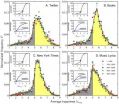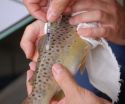(Press-News.org) "If it bleeds, it leads," goes the cynical saying with television and newspaper editors. In other words, most news is bad news and the worst news gets the big story on the front page.
So one might expect the New York Times to contain, on average, more negative and unhappy types of words — like "war," " funeral," "cancer," "murder" — than positive, happy ones — like "love," "peace" and "hero."
Or take Twitter. A popular image of what people tweet about may contain a lot of complaints about bad days, worse coffee, busted relationships and lousy sitcoms. Again, it might be reasonable to guess that a giant bag containing all the words from the world's tweets — on average — would be more negative and unhappy than positive and happy.
But new research shows just the opposite.
"English, it turns out, is strongly biased toward being positive," said Peter Dodds, an applied mathematician at the University of Vermont.
The UVM team's study "Positivity of the English Language," is presented in the Jan. 11 issue of the journal PLoS ONE.
This new study complements another study the same Vermont scientists presented in the Dec. 7 issue of PLoS ONE, "Temporal Patterns of Happiness and Information in a Global Social Network."
That work attracted wide media attention showing that average global happiness, based on Twitter data, has been dropping for the past two years.
Combined, the two studies show that short-term average happiness has dropped — against the backdrop of the long-term fundamental positivity of the English language.
In the new study, Dodds and his colleagues gathered billions of words from four sources: twenty years of the New York Times, the Google Books Project (with millions of titles going back to 1520), Twitter and a half-century of music lyrics.
"The big surprise is that in each of these four sources it's the same," says Dodds. "We looked at the top 5,000 words in each, in terms of frequency, and in all of those words you see a preponderance of happier words."
Or, as they write in their study, "a positivity bias is universal," both for very common words and less common ones and across sources as diverse as tweets, lyrics and British literature.
Why is this? "It's not to say that everything is fine and happy," Dodds says. "It's just that language is social."
In contrast to traditional economic theory, which suggests people are inherently and rationally selfish, a wave of new social science and neuroscience data shows something quite different: that we are a pro-social storytelling species. As language emerged and evolved over the last million years, positive words, it seems, have been more widely and deeply engrained into our communications than negative ones.
"If you want to remain in a social contract with other people, you can't be a…," well, Dodds here used a word that is rather too negative to be fit to print — which makes the point.
This new work adds depth to the Twitter study that the Vermont scientists published in December that attracted attention from NPR, Time magazine and other media outlets.
"After that mild downer story, we can say, 'But wait — there's still happiness in the bank," Dodds notes. "On average, there's always a net happiness to language."
Both studies drew on a service from Amazon called Mechanical Turk. On this website, the UVM researchers paid a group of volunteers to rate, from one to nine, their sense of the "happiness" — the emotional temperature — of the 10,222 most common words gathered from the four sources. Averaging their scores, the volunteers rated, for example, "laughter" at 8.50, "food" 7.44, "truck" 5.48, "greed" 3.06 and "terrorist" 1.30.
The Vermont team — including Dodds, Isabel Kloumann, Chris Danforth, Kameron Harris, and Catherine Bliss — then took these scores and applied them to the huge pools of words they collected. Unlike some other studies — with smaller samples or that elicited strong emotional words from volunteers — the new UVM study, based solely on frequency of use, found that "positive words strongly outnumber negative words overall."
This seems to lend support to the so-called Pollyanna Principle, put forth in 1969, that argues for a universal human tendency to use positive words more often, easily and in more ways than negative words.
Of course, most people would rank some words, like "the," with the same score: a neutral 5. Other words, like "pregnancy," have a wide spread, with some people ranking it high and others low. At the top of this list of words that elicited strongly divergent feelings: "profanities, alcohol and tobacco, religion, both capitalism and socialism, sex, marriage, fast foods, climate, and cultural phenomena such as the Beatles, the iPhone, and zombies," the researchers write.
"A lot of these words — the neutral words or ones that have big standard deviations — get washed out when we use them as a measure," Dodds notes. Instead, the trends he and his team have observed are driven by the bulk of English words tending to be happy.
If we think of words as atoms and sentences as molecules that combine to form a whole text, "we're looking at atoms," says Dodds. "A lot of news is bad," he says, and short-term happiness may rise and and fall like the cycles of the economy, "but the atoms of the story — of language — are, overall, on the positive side."
INFORMATION:
We may be less happy, but our language isn't
2012-01-13
ELSE PRESS RELEASES FROM THIS DATE:
Researchers find new, noninvasive way to identify lymph node metastasis
2012-01-13
TAMPA, Fla. (Jan. 12, 2012) – Using two cell surface markers found to be highly expressed in breast cancer lymph node metastases, researchers at Moffitt Cancer Center, working with colleagues at other institutions, have developed targeted, fluorescent molecular imaging probes that can non-invasively detect breast cancer lymph node metastases. The new procedure could spare breast cancer patients invasive and unreliable sentinel lymph node (SLN) biopsies and surgery-associated negative side effects.
Their study was published in a recent issue of Clinical Cancer Research ...
Scientists learn how stem cell implants help heal traumatic brain injury
2012-01-13
For years, researchers seeking new therapies for traumatic brain injury have been tantalized by the results of animal experiments with stem cells. In numerous studies, stem cell implantation has substantially improved brain function in experimental animals with brain trauma. But just how these improvements occur has remained a mystery.
Now, an important part of this puzzle has been pieced together by researchers at the University of Texas Medical Branch at Galveston. In experiments with both laboratory rats and an apparatus that enabled them to simulate the impact of ...
Explosives and fish are traced with chemical tags
2012-01-13
Researchers at the University of Oviedo (Spain) have come up with a way of tagging gunpowder which allows its illegal use to be detected even after it has been detonated. Based on the addition of isotopes, the technique can also be used to track and differentiate between wild fish and those from a fish farm, such as trout and salmon.
A new method for tagging and identifying objects, substances and living beings has just been presented in this month's issue of the Analytical Chemistry journal. Its creators are scientists at the University of Oviedo who have patented the ...
Discovery in Africa gives insight for Australian Hendra virus outbreaks
2012-01-13
A new study on African bats provides a vital clue for unravelling the mysteries in Australia's battle with the deadly Hendra virus.
The study focused on an isolated colony of straw-coloured fruit bats on islands off the west coast of central Africa. By capturing the bats and collecting blood samples, scientists discovered these animals have antibodies that can neutralise deadly viruses known in Australia and Asia.
The paper is published today, 12 January, in the journal PLoS ONE, and is a collaboration of the Department of Veterinary Medicine at the University of ...
Magnetic actuation enables nanoscale thermal analysis
2012-01-13
Polymer nano-films and nano-composites are used in a wide variety of applications from food packaging to sports equipment to automotive and aerospace applications. Thermal analysis is routinely used to analyze materials for these applications, but the growing trend to use nanostructured materials has made bulk techniques insufficient.
In recent years an atomic force microscope-based technique called nanoscale thermal analysis (nanoTA) has been employed to reveal the temperature-dependent properties of materials at the sub-100 nm scale. Typically, nanothermal analysis ...
New 'smart' nanotherapeutics can deliver drugs directly to the pancreas
2012-01-13
BOSTON, January 12, 2012: A research collaboration between the Wyss Institute for Biologically Inspired Engineering at Harvard University and Children's Hospital Boston has developed "smart" injectable nanotherapeutics that can be programmed to selectively deliver drugs to the cells of the pancreas. Although this nanotechnology will need significant additional testing and development before being ready for clinical use, it could potentially improve treatment for Type I diabetes by increasing therapeutic efficacy and reducing side effects.
The approach was found to increase ...
'Open-source' robotic surgery platform going to top medical research labs
2012-01-13
SANTA CRUZ, CA--Robotics experts at the University of California, Santa Cruz and the University of Washington (UW) have completed a set of seven advanced robotic surgery systems for use by major medical research laboratories throughout the United States. After a round of final tests, five of the systems will be shipped to medical robotics researchers at Harvard University, Johns Hopkins University, University of Nebraska, UC Berkeley, and UCLA, while the other two systems will remain at UC Santa Cruz and UW.
"We decided to follow an open-source model, because if all ...
Optical nanoantennas enable efficient multipurpose particle manipulation
2012-01-13
University of Illinois researchers have shown that by tuning the properties of laser light illuminating arrays of metal nanoantennas, these nano-scale structures allow for dexterous optical tweezing as well as size-sorting of particles.
"Nanoantennas are extremely popular right now because they are really good at concentrating optical fields in small areas," explained Kimani Toussaint, Jr., an assistant professor of mechanical science and engineering at the University of Illinois at Urbana-Champaign. "In this work, we demonstrate for the first time the use of arrays ...
Discrimination may harm your health, according to new Rice study
2012-01-13
Racial discrimination may be harmful to your health, according to new research from Rice University sociologists Jenifer Bratter and Bridget Gorman.
In the study, "Is Discrimination an Equal Opportunity Risk? Racial Experiences, Socio-economic Status and Health Status Among Black and White Adults," the authors examined data containing measures of social class, race and perceived discriminatory behavior and found that approximately 18 percent of blacks and 4 percent of whites reported higher levels of emotional upset and/or physical symptoms due to race-based treatment. ...
A scarcity of women leads men to spend more, save less
2012-01-13
The perception that women are scarce leads men to become impulsive, save less, and increase borrowing, according to new research from the University of Minnesota's Carlson School of Management.
"What we see in other animals is that when females are scarce, males become more competitive. They compete more for access to mates," says Vladas Griskevicius, an assistant professor of marketing at the Carlson School and lead author of the study. "How do humans compete for access to mates? What you find across cultures is that men often do it through money, through status and ...



